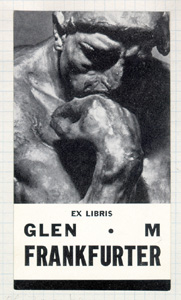
This 3,000 + bookplate and book seal collection is part of a series of digital collections created by McGill University Libraries in Montreal. As for why bookplates were chosen, the home page states: "Although the study of bookplates may seem trivial, or, for that matter an esoteric subject, at first, glance, in fact they reveal a great deal about our book-centred culture. Bookplates not only denote ownership, and can also help to protect against theft. For many institutions, bookplates possess an iconographic or emblematic value reflecting the values of the institution. As well, within an institutional setting, bookplates are often used to acknowledge individual collections, gifts and bequests. Finally, for the individual the bookplate is a powerful symbol of possession and a love of book."
The project was funded by a grant in 2002 and was apparently organized/digitized by a group of volunteers. There is a brief bio. about Phillipe Masson (1911-1944) whose collection of ephemera was given to the university in 1972, and a scope note with some information about how the collection, including Masson's, are indexed and divided. Although there is no metadata for how those images were digitized at that time, McGill does provide information on its current digitization processes. According to McGill's Technical Specifications page, the following are currently used for imaging: books - Image Capture ProgRes 3012 digital camera back on a TTI Reprographic Workstation; larger images - Image Capture BetterLight 8K digital camera back on a Devere copy stand; lighting is provided by independently mounted Buhl lighting pod. Their software includes: Image Capture: Adobe Photoshop 8.0 Professional; Optical Character Recognition: ABBYY Finereader Professional 7.0; XML Tagging is provided by XMLSpy 2005 Professional.
Searching can be done by a keyword; advanced searches can be conducted by owner, motto or date, with drop-down menues for iconography, medium an type. A search result provides a thumbnail, owner, type, appearance and full record. Clicking on the thumbnail does not enlarge the image. The full record link opens a larger image that can be clicked on to enlarge again in a separate window with some information about grid size (which is unclear). The full record includes brief information on the volume (apparently in which the plate appears), the bookplate number (by whom?), owner (of the original plate), type ( of image), appearance (color, bw), iconography (presumably controlled vocabulary), medium (presumably controlled vocabulary), and references (the relevance is unclear).

All in all, the metadata for the images is too brief, and not being able to click on thumbnails to open an image was frustrating. I'm not sure how extensive the keyword search list is. I found a bookplate with a cat, but that plate did not turn up on the search results list using "cat". I think the keywords are based on text printed on the seal or plate. That obvious omission precludes any searches by keyword derived from image content. I suppose those interested in bookplate art would find this interesting.
I suppose something is better than nothing but frankly this digitization is very cumbersome.
ReplyDeleteLew Jaffe